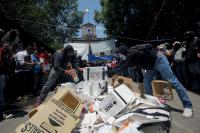Despite widespread d isillusionment with the political system, an organized attempt to prevent the election from taking place in a few states, and continuing economic doldrums, President Enrique Peña Nieto and his Institutional Revolutionary Party (PRI) were the big winners in the Mexican election, followed by the conservative National Action Party (PAN). Both parties are committed to continuing the deepening of the country's neoliberal, free market economic reforms.
isillusionment with the political system, an organized attempt to prevent the election from taking place in a few states, and continuing economic doldrums, President Enrique Peña Nieto and his Institutional Revolutionary Party (PRI) were the big winners in the Mexican election, followed by the conservative National Action Party (PAN). Both parties are committed to continuing the deepening of the country's neoliberal, free market economic reforms.
The Mexican left of all stripes lost, in some cases disastrously. The left parties that participated in the election saw their percentages of the national vote decline, while the left groups that attempted to prevent the election from taking place were successful in only some cities and towns and in only a few states. While more than half of all Mexicans did not vote, that seems to have been more a result of typical voter apathy or general disgust with the government and the parties than the result of the boycott or the campaign to prevent voting.
The PRI won 29 percent of the vote and the PAN 20 percent, while several competing leftist parties divided their vote, the Party of the Democratic Revolution (PRD) received 10.8, the Movement of National Regeneration (MORENA) 8.3 percent and the Citizens Movement, 5.9 percent, while the Workers Party (PT), received only 2.87 percent, too little to keep its registration and ballot status. MORENA took comfort from winning a majority of seats in the Mexico City legislature, surpassing its rival the PRD.
The PRI and its allied parties, such as the Green Ecological Party and the New Alliance Party, will have large pluralities in both house of the Mexican Congress.
The National Coordinating Committee (la CNTE), a dissident caucus within the Mexican Teachers Union (el SNTE)–arguing that the government, electoral authorities and the parties are utterly corrupt–prevented the National Electoral Institute (INE) from setting up hundreds of polling places in several cities and towns in Oaxaca, Guerrero, and Chiapas.
The teachers originally called for a boycott, but rather than attempting to persuade voters not to vote, they made it impossible wherever they could. In some places the teachers and their allies burned polling booths and ballots or in other ways discouraged or prevented their fellow citizens from voting.
In some towns the teachers found themselves at odds with locals who wanted to participate in the elections while in others they faced repression from the police. But in most of the other 32 states the election went as planned without substantial problems. The call for a national boycott of the election failed.
The Mexican left is now in the weakest position in electoral politics since the 1980s. Between the late-1980s and the 2010s the left united behind the PRD could generally win about one third of the vote. Now no left party has more than about 10 percent. Andrés Manuel López Obrador, leader of MORENA, has pledged that his party will not join in a coalition with the PRD in the coming presidential election in 2018.


Leave a Reply